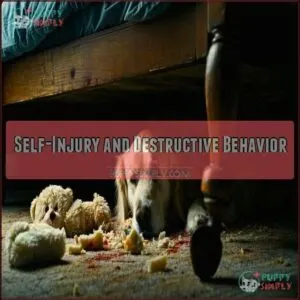This site is supported by our readers. We may earn a commission, at no cost to you, if you purchase through links.

Dogs have natural instincts to seek out cozy, enclosed spaces where they can feel protected, especially when they’re anxious or overwhelmed.
Loud noises, new environments, or even health issues can push them to retreat under your bed, think of it as their version of curling up under a blanket.
If this behavior seems unusual or excessive, it could signal stress, fear, or discomfort, providing calming alternatives or a comfy dog bed might encourage them to hang out elsewhere.
Table Of Contents
- Key Takeaways
- Dog Sleeping Habits
- Why Dogs Sleep Under Bed
- Causes of Hiding Behavior
- Recognizing Anxiety Signs
- Redirecting Sleeping Habits
- Creating a Safe Environment
- Frequently Asked Questions (FAQs)
- Why does my dog sleep under the bed?
- Why is my dog sleeping so hard?
- Should a puppy sleep under the bed?
- Why does my dog hide under the bed?
- How do I Stop My Dog from Sleeping Under my Bed?
- Why is my dog retreating under a bed?
- Why does my dog have to sleep under me?
- What are the reasons for sleeping a lot?
- Why does my dog scavenge under the bed?
- Why does my dog Scurry under the bed?
- Conclusion
Key Takeaways
- Your dog sleeps under the bed because it mimics a safe, cozy den, satisfying their natural instincts for security and comfort.
- Loud noises, stress, or changes in the environment often drive dogs to seek this hidden spot as a refuge.
- If your dog suddenly starts hiding under the bed more often, it could signal anxiety, illness, or discomfort, so keep an eye on their behavior.
- Redirect their sleeping habits by offering a comfortable alternative like a cozy dog bed or crate with familiar items and positive reinforcement.
Dog Sleeping Habits
Your dog’s sleeping habits are shaped by natural instincts and their desire for comfort. Understanding these behaviors can help you create a safe and cozy space they’ll love.
Instinctual Behavior
Dogs’ instinctual behavior often ties back to their ancestors’ need for survival.
They naturally seek den-like spaces for security and comfort. This behavior might feel familiar when you see them under your bed.
Here’s why:
- Shelter Seeking: It mimics a safe burrow.
- Canine Security: Offers protection from perceived threats.
- Ancestral Behavior: Tapping into those natural instincts.
Natural Den Instinct
Your dog’s behavior ties back to their wild ancestry, where creating dens provided shelter and security.
Dogs instinctively seek cozy, enclosed spaces like dens, offering them comfort, security, and a sense of safety from their wild ancestry.
That instinctual desire to find a cozy den environment still lingers.
The space under your bed mimics a safe, enclosed dog den environment—perfect for comfort zones.
This natural den instinct reflects their innate need for a calm, secure space to feel at ease.
Seeking Safety and Security
Ever wonder why your furry friend curls up under the bed?
It’s all about feeling safe. That hidden spot mimics a den, satisfying their natural denning instinct.
Dogs with noise sensitivity or anxiety often view it as a safe space. Whether seeking comfort, escaping stress, or responding to past trauma, this cozy nook helps them feel secure.
Why Dogs Sleep Under Bed
Your dog sleeping under the bed might seem odd, but it often ties back to instinct and comfort.
Dogs are den animals, meaning they naturally seek enclosed spaces, especially when they want to feel safe. The area under your bed offers a cozy, private spot that mimics a den, fulfilling their need for shelter and security.
Here’s a quick breakdown of why this happens:
- Den Instincts: Dogs instinctively crave enclosed spaces for protection and relaxation.
- Noise Sensitivity: Loud sounds like fireworks or thunder make under the bed a refuge.
- Injury Avoidance: If your dog feels unwell, they may hide under the bed to retreat safely.
- Scent Comfort: Your scent clings to the space, providing reassurance.
- Scavenging Behavior: Dogs might stash food or toys there, turning it into their secret hangout.
Understanding this behavior reveals their need for comfort and security! This is similar to how dogs seek comfort by snuggling for security.
Causes of Hiding Behavior
Your dog might hide under the bed because they’re feeling anxious, stressed, or unwell.
This behavior often comes from their instincts to seek safety and comfort when something feels off.
Anxiety and Fear
When your furry friend hides under the bed, it might be anxiety or fear at play.
Loud noises, like fireworks, can trigger noise sensitivity. Separation anxiety or past trauma history can also lead them there.
Fear aggression, pacing, or trembling are common signs.
Try calming techniques or creating a soothing space to ease their distress.
Stress and Environmental Changes
Changes like moving to a new home or switching up routines can unsettle your pup.
Noise sensitivity also plays a big role—loud bangs or unfamiliar sounds may send them under the bed.
Environmental triggers, like rearranged furniture, can spike dog stress.
These shifts disrupt stability, leading to dog hiding as a way to cope with anxiety and regain control.
Physical Injury or Illness
Sometimes, a dog sleeping under your bed might be hiding because it feels unwell.
Illness, physical injury, or pain often trigger this instinct. Watch for pain indicators like lethargy or behavioral changes.
If hiding becomes frequent, consult your veterinarian to rule out health concerns.
Addressing health issues early can prevent discomfort, keeping your furry friend happy and secure.
Recognizing Anxiety Signs
When your dog hides under the bed, it might be their way of coping with anxiety or fear.
Paying attention to signs like pacing, panting, or changes in appetite can help you understand what they’re feeling.
Panting and Pacing
Panting and pacing often reveal dog anxiety or discomfort. It’s like your dog’s way of saying, “I’m uneasy!”
Watch for these stress indicators:
- Fast, shallow breathing (possible hyperthermia signs).
- Restless pacing, especially during anxiety triggers like loud noises.
- Unusual breathing problems without clear cause.
- Repeated behavior near stressful situations.
If these signs persist, consider a veterinary assessment to rule out serious issues.
Self-Injury and Destructive Behavior
When anxiety kicks in, dogs might hide under the bed while engaging in destructive chewing or even self-injury.
Behavioral triggers like boredom or fear often lead to this.
Injury prevention starts with understanding their stress.
Encourage calm with environmental enrichment and anxiety relief tools.
A common issue is dog separation anxiety.
Keeping an eye on your dog’s behavior guarantees their safety and comfort at home.
Loss of Appetite and Lethargy
If your dog sleeps under the bed and seems lethargic or uninterested in food, it could point to underlying illnesses or nutritional deficiencies.
Behavioral changes like lack of appetite may signal pain indicators or dog illness.
A veterinary consultation is key to understanding potential issues.
Don’t wait—early veterinary care can uncover problems, ensuring your dog gets the help it needs, which may involve addressing underlying illnesses or nutritional deficiencies.
Redirecting Sleeping Habits
Helping your dog find a new favorite sleeping spot takes patience and consistency.
With simple steps like crate training, setting routines, and offering cozy alternatives, you can guide them to a more suitable space.
Crate Training and Positive Reinforcement
A dog’s anxiety can be eased with crate training and positive reinforcement.
Introduce the crate gradually, creating positive associations with treats and praise. Proper crate size is critical for success.
Use these steps to build a safe space:
- Add soft bedding for comfort.
- Use a reward system to encourage use.
- Keep training consistent.
- Avoid forcing them inside.
- Make the crate feels welcoming.
The key to successful crate training is to make the crate feel like a welcoming space for the dog.
Providing Alternative Spaces
Try offering Den Alternatives like cozy dog beds or crates in quiet, Safe Zones.
Add Comfort Items like blankets or toys with familiar scents.
Place these alternative sleeping spots near where your dog feels secure, avoiding busy areas.
You might consider purchasing comfortable bedding for their new space.
A Gradual Shift with treats and praise helps.
It’s all about creating enticing spaces that rival under-the-bed comforts!
Establishing a Routine
Establishing a routine helps your dog feel secure and balanced. A consistent schedule builds comfort and predictability.
Try these steps:
- Set feeding times to anchor their day.
- Stick to regular exercise patterns to use up energy positively.
- Create bedtime rituals like brushing or belly rubs.
These patterns can redirect the behavior of a dog sleeping under the bed.
Creating a Safe Environment
Your dog needs a calm, predictable environment to feel safe and secure. Reducing noise, keeping changes minimal, and adding familiar comforts can make a big difference.
Reducing Noise and Stress
Stress from loud noises like thunderstorms can lead to your dog sleeping under the bed.
Loud noises like thunderstorms often send dogs seeking refuge under the bed, their safe haven from stress and anxiety.
Sound masking, like white noise machines, helps reduce noise sensitivity.
Create a Safe Zone with cozy bedding and calming techniques like music for dogs.
Routine consistency eases stress, while Environmental Enrichment—like toys—keeps them occupied during noisy times.
It’s like giving them peace on demand. Many owners find calming music effective for anxious dogs.
Minimizing Changes
If your dog’s sleeping under the bed seems tied to stress, routine stability can help.
Dogs thrive on predictable environments. Stick to consistent schedules for feeding, walks, and playtime—avoiding surprises, like sudden environmental changes.
Gradual introductions to new spaces or routines ease stress. Stability offers comfort, helping prevent your dog from seeking shelter under the bed.
Some owners also find dog calming products beneficial for anxious pets. Keep things calm!
Providing Familiar Comforts
Making your dog feel secure starts with familiar comforts.
Place soft bedding near you to satisfy their denning instinct and owner proximity needs. Add favorite toys or blankets carrying their scent association.
Calming sounds like soft music can ease dog anxiety.
Consider using stainless steel bowls, as outlined in an ultimate puppy checklist.
These touches create a safe haven, perfect for soothing your dog’s nerves and reinforcing their sense of comfort.
Frequently Asked Questions (FAQs)
Why does my dog sleep under the bed?
It’s like your dog’s creating their own little fort.
They feel safe, cozy, and hidden under the bed.
It’s a den-like spot for comfort, escaping noise, or even dealing with stress.
Why is my dog sleeping so hard?
Your dog might be in a deep sleep because they feel comfortable, exhausted after play, or simply need extra rest.
Dogs, like us, have sleep cycles, and sometimes they’re just really indulging in dreamland!
Should a puppy sleep under the bed?
It’s fine if your puppy sleeps under the bed, but make sure it’s safe and clean.
They might feel comforted by the cozy space.
However, crate training could provide a better, secure alternative.
Why does my dog hide under the bed?
Your dog hides under the bed for safety, comfort, or stress relief.
It’s their private escape from noise, anxiety, or illness, much like a “den” in the wild.
Watch for sudden changes or unusual behavior.
How do I Stop My Dog from Sleeping Under my Bed?
It’s ironic how your dog’s escape spot becomes your challenge.
Offer a cozy crate or bed, reward them for using it, and block under-bed access.
Consistency, patience, and positive reinforcement will do the trick!
Why is my dog retreating under a bed?
Your dog might retreat under the bed for comfort, security, or peace.
It’s their way of finding a safe haven, especially if they’re stressed, anxious, or unwell.
Observe them, and consult a vet if needed.
Why does my dog have to sleep under me?
Think of it as your dog seeking shelter under their favorite tree.
They crave your scent for comfort and security, embracing the closeness as a den-like retreat, fueled by love and instinct.
What are the reasons for sleeping a lot?
Sleeping a lot can happen from physical exhaustion, poor sleep, or stress.
It could also mean anemia, depression, or thyroid issues.
If it’s sudden or extreme, check with a doctor to rule out health problems.
Why does my dog scavenge under the bed?
Like a treasure hunter, your dog may scavenge under the bed to find hidden snacks, toys, or intriguing scents.
It’s their curious nature and instinct to explore cozy, overlooked spots for surprises.
Why does my dog Scurry under the bed?
Your dog scurries under the bed for comfort, safety, or to escape stress.
It’s a den-like hideout, perfect for avoiding noise, anxiety, or overwhelming moments.
Their instincts tell them it’s their cozy sanctuary.
Conclusion
Your dog sleeping under your bed might seem like a quirky habit, but it’s their way of finding comfort and safety.
It can stem from instincts, stress, or even health issues.
Pay attention to triggers like loud noises or changes in routine.
To help, create a cozy spot or try crate training.
If they seem anxious or the behavior is unusual, talk to your vet.
Remember, your dog’s hiding isn’t random—it’s their way of feeling secure.
- https://www.tuftsyourdog.com/doghealthandmedicine/dear-doctor-the-dog-likes-to-relax-in-tight-spaces/
- https://todaysveterinarypractice.com/pain-assessment-in-dogs-and-cats/
- https://veterinary-practice.com/article/the-treatment-of-noise-phobic-dogs
- https://www.vetyourpets.com/about
- https://www.sciencedirect.com/science/article/pii/S2352154619301378
















